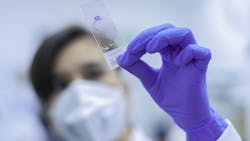Nanotech destroys bacteria and fungal cells
Researchers have developed a new superbug-destroying antimicrobial coating that could be used on wound dressings and implants to prevent and treat potentially deadly bacterial and fungal infections, while leaving human cells unharmed, reported RMIT University.
Antibiotic resistance is a major global health threat, causing at least 700,000 deaths a year. Without the development of new antibacterial therapies, the death toll could rise to 10 million people a year by 2050, equating to $US 100 trillion in healthcare costs. While the health burden of fungal infections is less recognized, globally they kill about 1.5 million people each year and the death toll is growing. An emerging threat to hospitalized COVID-19 patients for example is the common fungus, Aspergillus, which can cause deadly secondary infections.
The new coating from a team led by RMIT is based on an ultra-thin 2D material that until now has mainly been of interest for next-generation electronics. Studies on black phosphorus (BP) have indicated it has some antibacterial and antifungal properties, but the material has never been methodically examined for potential clinical use. The new research, published in the American Chemical Society’s journal Applied Materials & Interfaces, reveals that BP is effective at killing microbes when spread in nanothin layers on surfaces like titanium and cotton, used to make implants and wound dressings.
Co-lead researcher Dr Aaron Elbourne said finding one material that could prevent both bacterial and fungal infections was a significant advance. “Our nanothin coating is a dual bug killer that works by tearing bacteria and fungal cells apart, something microbes will struggle to adapt to. It would take millions of years to naturally evolve new defenses to such a lethal physical attack.”
As BP breaks down, it oxidizes the surface of bacteria and fungal cells. This process, known as cellular oxidization, ultimately works to rip them apart. In the new study, first author and PhD researcher Zo Shaw tested the effectiveness of nanothin layers of BP against five common bacteria strains, including E. coli and drug-resistant MRSA, as well as five types of fungus, including Candida auris. In just two hours, up to 99% of bacterial and fungal cells were destroyed. The BP also began to self-degrade in that time and was entirely disintegrated within 24 hours – an important feature that shows the material would not accumulate in the body. The laboratory study identified the optimum levels of BP that have a deadly antimicrobial effect while leaving human cells healthy and whole. The researchers have now begun experimenting with different formulations to test the efficacy on a range of medically relevant surfaces.
